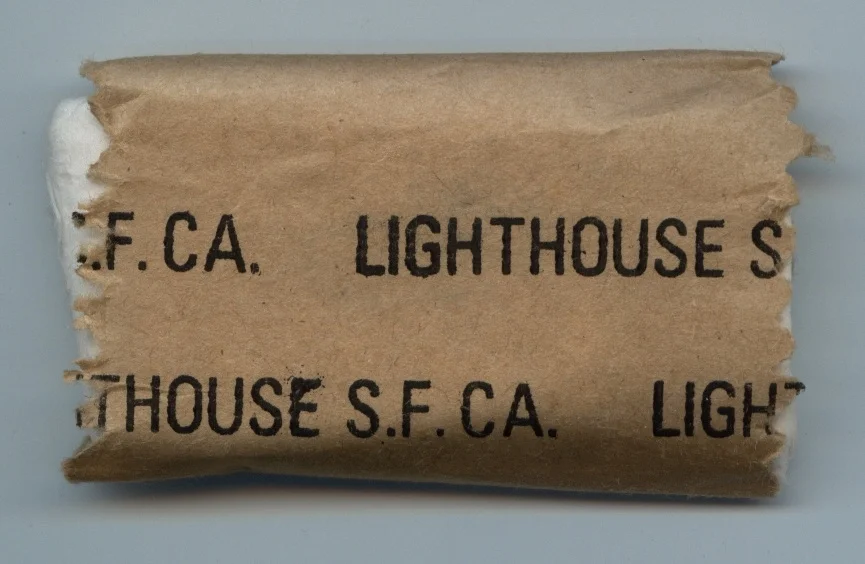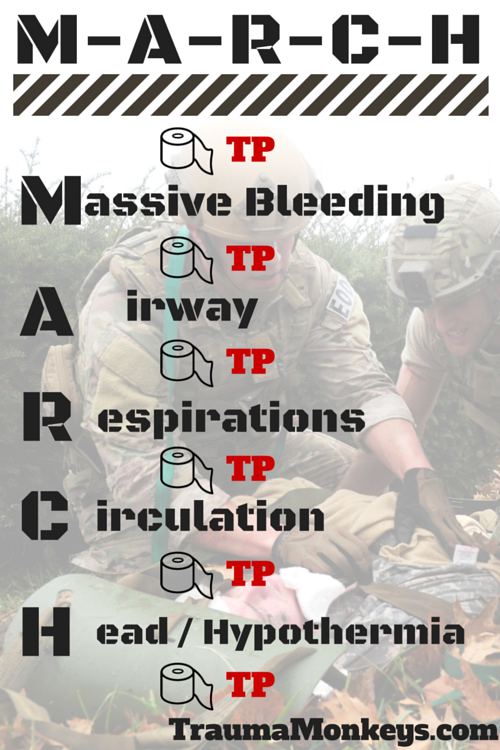Tactical Pause not Toilet Paper
For those of you, who haven't had the pleasure of using standard issue military toilet paper, you may not know that it's sometimes referred to as John Wayne paper because it's tough and doesn't take crap off anyone.
The TP I want to talk about today is not a hygiene product it's the Tactical Pause and it's something you should start incorporating into your training ASAP-ually.
Anyone familiar with TCCC / TECC principles should be familiar with the M-A-R-C-H mnemonic. The letters represent medical interventions and the order they should be performed on a trauma patient.
There are an infinite number of variations on this theme MARCH-E, XABC, T-MARCH-P, GFYS, the list goes on and on. The mnemonic serves as a reminder of how to address the preventable causes of death in trauma patients and how to avoid getting mud sucked into distracting injuries. Learning and utilizing MARCH, builds muscle memory and keeps the care giver on task. The idea is to attack the life threatening injuries first, and avoid the pitfalls of distracting and sometimes visually mesmerizing wounds.
As a medic, first responder, or first care provider your primary responsibility above and beyond all else is safety; yours and that of your teammates. Wanting to help those in need is a noble and admirable notion. In fact, it's the reason many of us were drawn into the professions we've chosen. Becoming an additional casualty only compounds the current problem. The goal is to become the solution and not part of the problem.
SITUATIONAL AWARENESS
Situational Awareness (SA) is (Source: Mica Endsley – 1988): The perception of the elements in the environment within a volume of time and space, the comprehension of their meaning, and the projection of their status in the near future. Simply stated it's knowing what is going on around you at all times.
One would think maintaining awareness of ones surroundings when a potential threat exists is second nature (think Active Shooter). I'm sorry to report that it is about as common as common sense. Involvement in high stress situations typically triggers our fight or flight response, resulting in tachycardia, hyper-arousal, fixation (tunnel vision), confusion, sensory overload, and fatigue, the list goes on and on. None of these things improve performance.
“Under Pressure, you don’t rise to the occasion, you default to the level of your training.””
How do we do ensure our own safety in a combat zone, or as part of a rescue task force headed into an active shooter event or even when we are providing assistance on the freeway? First and foremost we train. We learn, practice, and incorporate sound principles that keep us dialed in. We also rely heavily on teamwork, knowing you can trust your teammates is what allows you to put your life in their hands and to accomplish amazing things. I know it's corny but " teamwork really does make the dream work".
Taking any focus off of your surroundings in a hostile environment to render aid is, was, and always will be a dangerous. The scene will never be "SAFE". It will however be "Safe enough". As a tactical medic that safety is made possible by the trust I developed in my military / Law enforcement brethren. Knowing that they are situationally dialed in, allows me provide better care at the point of injury and to TEMPORARILY take my eyes off my surroundings. That being said I continually reassess my surroundings and take a tactical pause by looking up and scanning. My eyes come off the patient and I re-evaluate what phase of care I should be in. This doesn't have to take more than a second or two, but it's a critical step.
Situations can change in the blink of an eye and if your undivided attention is on providing care for the casualty you will not see these changes, regardless of how obvious it should be.
As a tactical medic I try to anticipate changes in my environment and I take a disciplined approach to treatment by building muscle memory and safe habits. I do this by incorporating a " Tactical Pause" prior to rendering aid and after each step of the MARCH sequence.
At the completion of Major Bleeding - I Stop and look up and around for just a second or so. I Observe, Orient, Decide, and ACT (OODA Loop).
- Can I keep doing what I am doing?
- Should I keep doing what I'm doing?
- Has the situation changed?
- Have I heard or asked for an update on the situation?
- Am I still in the same phase of care?
- Is the guy that was holding security for me still there?
- Am I the only idiot that hasn't found cover?
- What are my outs, if the phase of care changes and I need to bail where am I headed?
Stop and think to yourself "What are my options and what is the smartest way to proceed?". I can remember being a young Corpsman with Marines and humping a huge ruck in addition to a large Medical bag (way before the M9) just waiting for something bad to happen, so I could rush out there and demonstrate my medical prowess, and prove my worth. Having seen with my own eyes the danger in rushing out there, I'm thankful to still be alive and that I was never in a situation where my eagerness cost me or worse a teammate their life. I can also recall a number of occasions where I gave great medical care and no one was around to notice because they were all in much safer spots.
Summary
If you've been in this line of work for any length of time, you probably already take these pauses instinctively. I wanted to give it a name and convey the importance especially to those of you that are in the business of teaching and passing on knowledge.
"Look before you leap", and incorporate the Tactical Pause into your training.
What tips or training techniques do you use to maintain situational awareness?
“So you’re a little bit older and a lot less bolder
Than you used to be”
Want More Trauma Monkeys?
Thanks so much for checking out the post and as always your comments are greatly appreciated. So please chime in.
REFERENCES
Boyd: The Fighter Pilot Who Changed the Art of War by Robert Coram
Toward a Theory of Situation Awareness in Dynamic Systems. Mica R. Endsley
.










